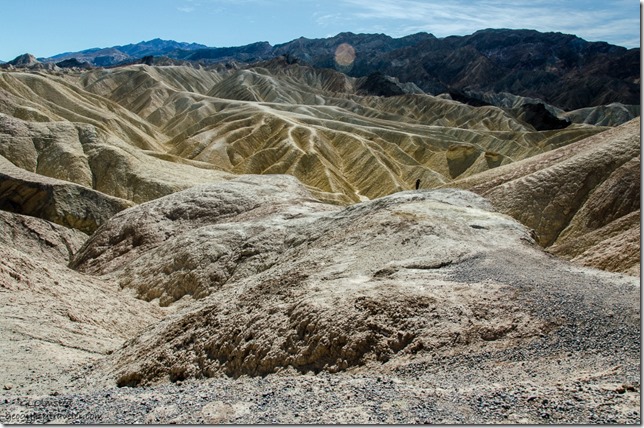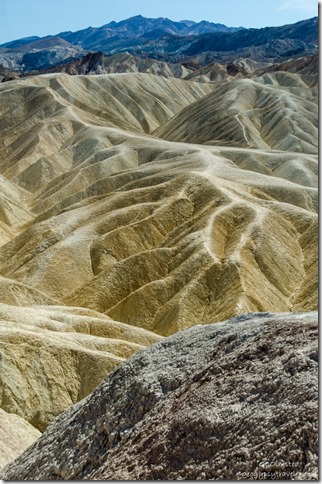February 19, 2016
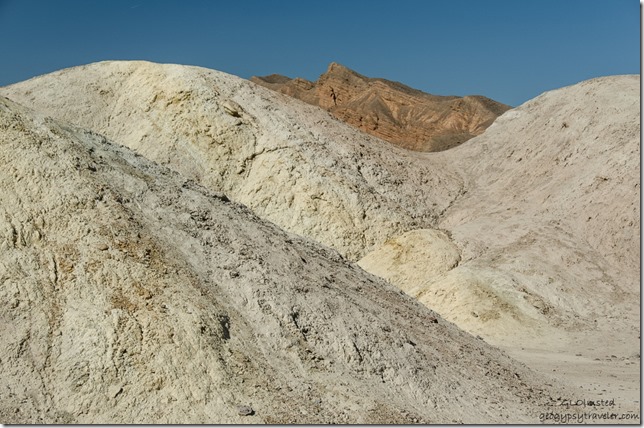 Our third day visiting Death Valley for the Super Bloom included a drive up and down to Dante’s View & Zabriskie Point. With so much diversity in the park we couldn’t limit ourselves to just flowers because the geologic story is ancient and mind-boggling.
Our third day visiting Death Valley for the Super Bloom included a drive up and down to Dante’s View & Zabriskie Point. With so much diversity in the park we couldn’t limit ourselves to just flowers because the geologic story is ancient and mind-boggling.
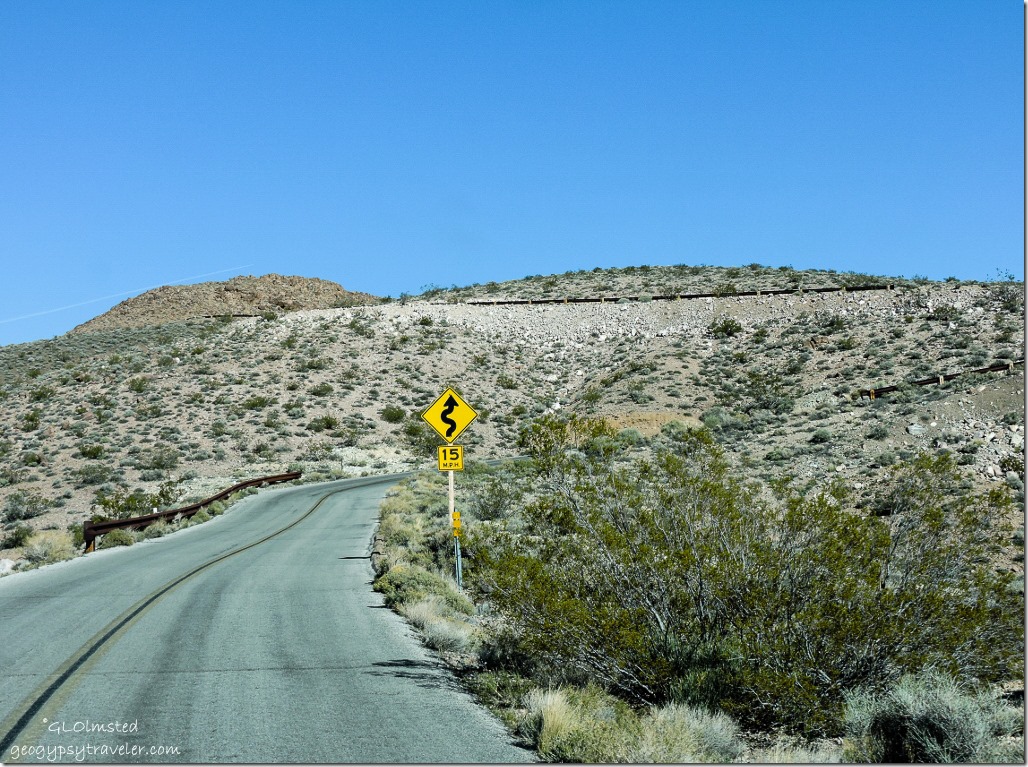 The 13-mile drive up to Dante’s View is challenging, two-lane paved, no shoulder, tight curves at the top, 5000 feet above the valley floor, and limited to vehicles no longer than 25 feet. Just my kind of road.
The 13-mile drive up to Dante’s View is challenging, two-lane paved, no shoulder, tight curves at the top, 5000 feet above the valley floor, and limited to vehicles no longer than 25 feet. Just my kind of road.
 The wind smacked us in the face as soon as we stepped out of the truck, a cold wind compared to the valley far below. But oh so worth it, briefly, for the view. I always love looking back at a place I’ve been or to a place I’m going. Not only did Dante’s provide the biggest view of the valley but also 11049 foot (3368 m) Telescope Peak in the snowy Panamint Range to the west.
The wind smacked us in the face as soon as we stepped out of the truck, a cold wind compared to the valley far below. But oh so worth it, briefly, for the view. I always love looking back at a place I’ve been or to a place I’m going. Not only did Dante’s provide the biggest view of the valley but also 11049 foot (3368 m) Telescope Peak in the snowy Panamint Range to the west.
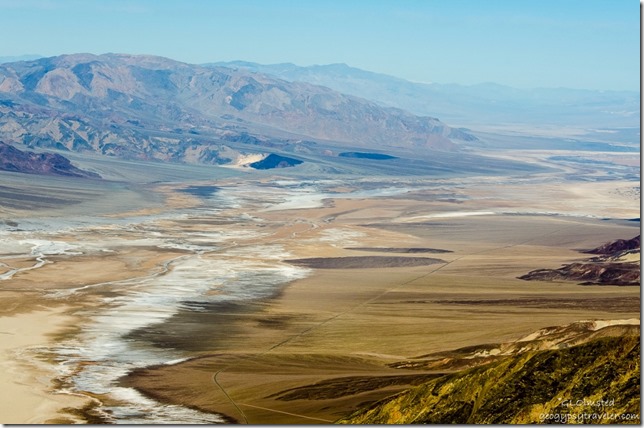 Death Valley sits between two gigantic mountain ranges today, Panamint to the west and Amargosa to the east. Yet in the geologic past this area has been covered by oceans, lakes, beaches, rivers, lava, and ash leaving behind multiple layers of limestone and sandstone sediments. The story began ~250mya (million years ago) when a shallow sea receded and movement of tectonic plates over the next 180my (million years) caused the earth’s crust to uplift, stretch, and fracture, forming fault lines. Tilting and rotating of two blocks of land between faults created Badwater Basin and the mountain ranges on either side. On top of these growing ranges volcanic ash and cinders were deposited over 60my and eventually revealed as the colors at Artists Palette. Then about 3mya crustal movement changed and the valley began to form, slipping downward along the fault that lies at the base of the Black Mountains to the east. At the same time, erosion from the mountains deposits rock in the valley. I guess it all balances out right now but will change again.
Death Valley sits between two gigantic mountain ranges today, Panamint to the west and Amargosa to the east. Yet in the geologic past this area has been covered by oceans, lakes, beaches, rivers, lava, and ash leaving behind multiple layers of limestone and sandstone sediments. The story began ~250mya (million years ago) when a shallow sea receded and movement of tectonic plates over the next 180my (million years) caused the earth’s crust to uplift, stretch, and fracture, forming fault lines. Tilting and rotating of two blocks of land between faults created Badwater Basin and the mountain ranges on either side. On top of these growing ranges volcanic ash and cinders were deposited over 60my and eventually revealed as the colors at Artists Palette. Then about 3mya crustal movement changed and the valley began to form, slipping downward along the fault that lies at the base of the Black Mountains to the east. At the same time, erosion from the mountains deposits rock in the valley. I guess it all balances out right now but will change again.
 Watched a hawk soar on the hellish winds. Just imagine its view.
Watched a hawk soar on the hellish winds. Just imagine its view.
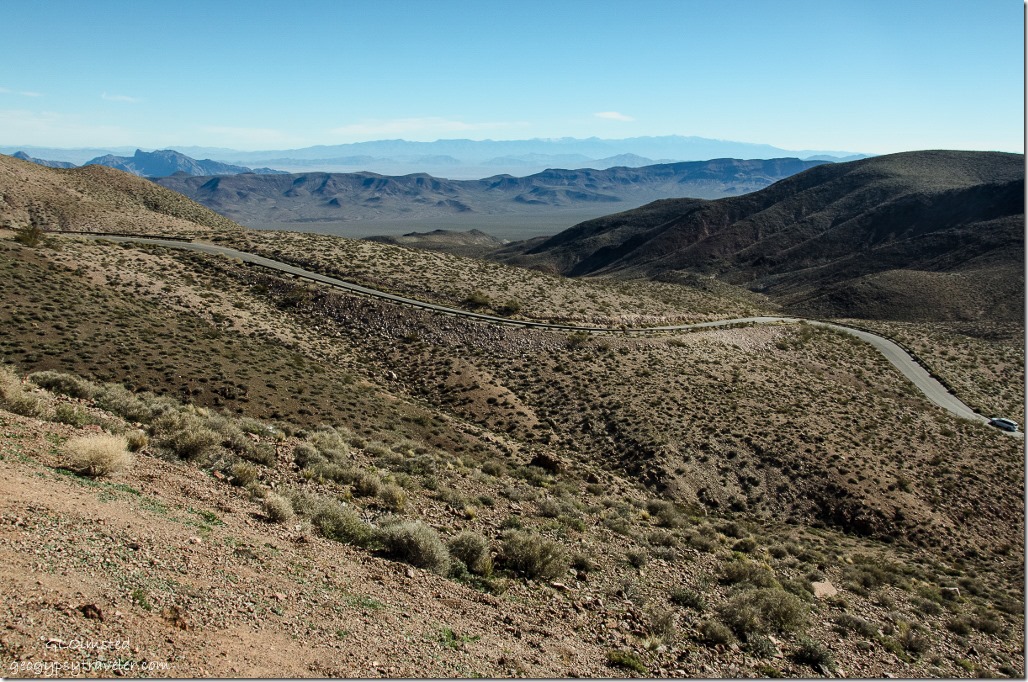 Then back down the road we went.
Then back down the road we went.
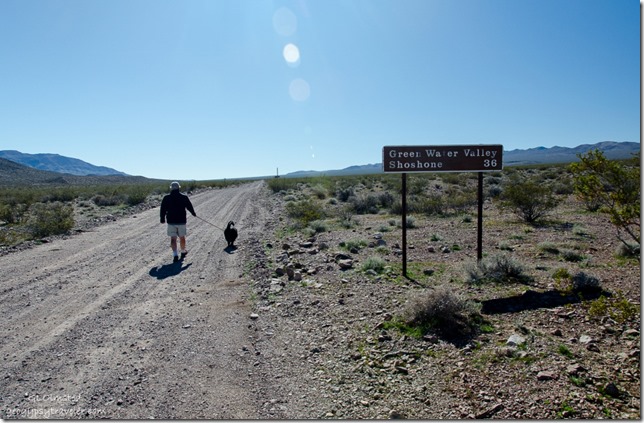 Made a stop to take Sasha for a walk on the gravel Greenwater Valley Road. One of few places in the park where dog walking is allowed. Although the road was signed for high clearance 4×4 the part we walked looked doable by any vehicle and could be an interesting route to Shoshone. Especially with the southeastern entrance into the park currently closed due to flood damage. You can also boondock along this road one mile beyond the paved junction. Something to consider if trying to escape summer heat in the valley.
Made a stop to take Sasha for a walk on the gravel Greenwater Valley Road. One of few places in the park where dog walking is allowed. Although the road was signed for high clearance 4×4 the part we walked looked doable by any vehicle and could be an interesting route to Shoshone. Especially with the southeastern entrance into the park currently closed due to flood damage. You can also boondock along this road one mile beyond the paved junction. Something to consider if trying to escape summer heat in the valley.
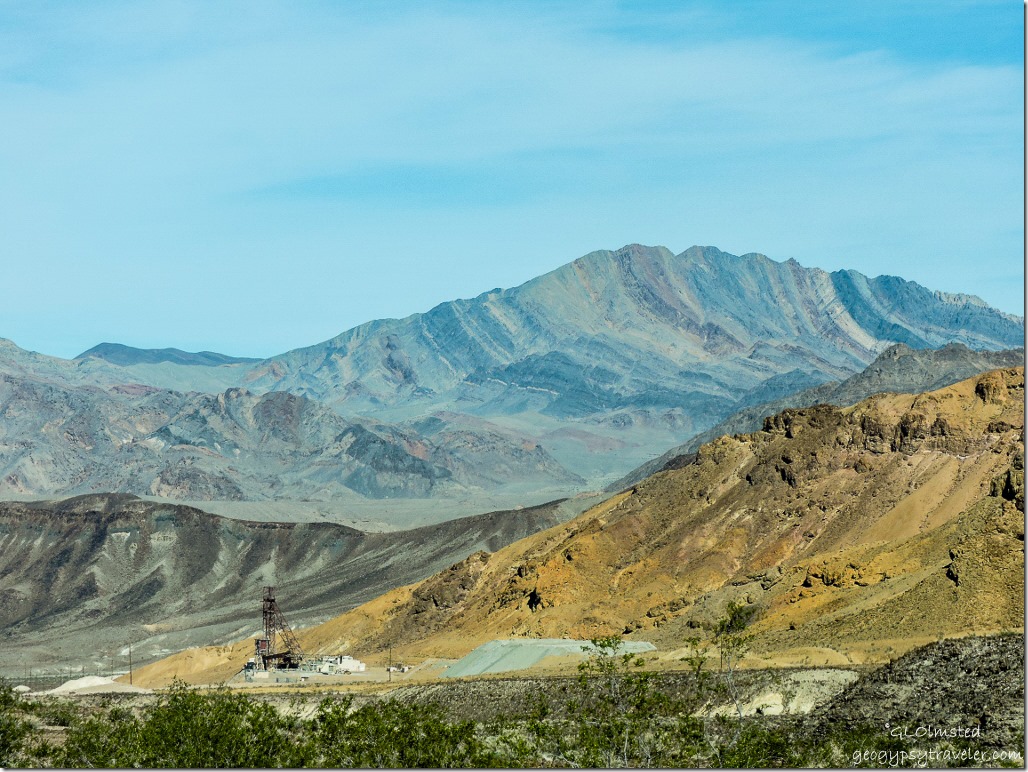 The lower section of the road to Dante’s View parallels the park boundary and evidence of mining is visible along the way. What a rough country to work and live in. Note the tipped and curved layers of rock in the distant mountains.
The lower section of the road to Dante’s View parallels the park boundary and evidence of mining is visible along the way. What a rough country to work and live in. Note the tipped and curved layers of rock in the distant mountains.
 Next stop Zabrisikie Point, 100 yards from the parking lot the paved trail funnels visitors to known features and overlooks.
Next stop Zabrisikie Point, 100 yards from the parking lot the paved trail funnels visitors to known features and overlooks.
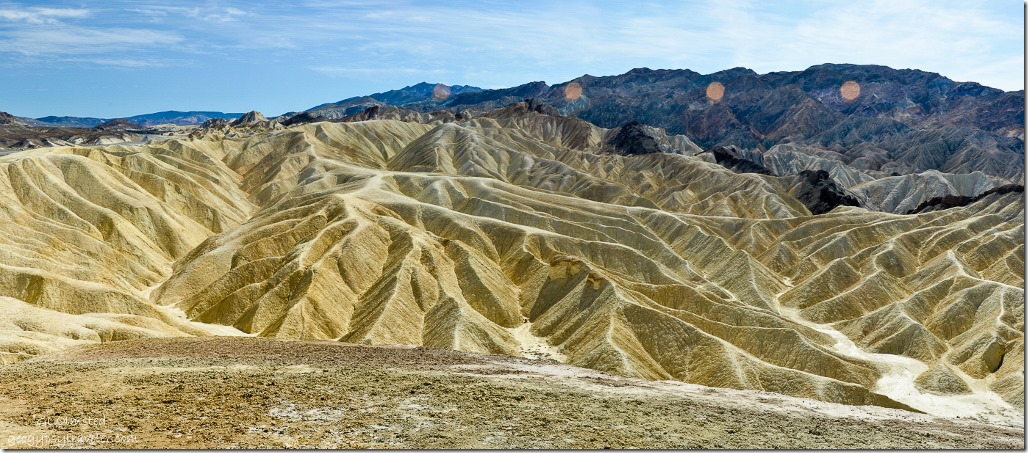 Panorama shot with multiple sun-spots
Panorama shot with multiple sun-spots
The badlands, with trails wandering in all directions. Erosion is one of the best tools for sculpting the earth, water, wind, and us.
The almost other worldly landscape seen at Zabriskie Point is part of the Amargosa Range on the east side of Death Valley. However, about 9-5mya lakes filled a long, mountain filled valley here. Fine silt and volcanic ash washed into the lakes, settling to the bottom, and ultimately creating a thick deposit of clay, sandstone and siltstone called the Furnace Creek Formation. Due to change in climate the lakes dried. The primary source of borate minerals gathered from Death Valley is from this 5000 feet (1500 m) thick formation.
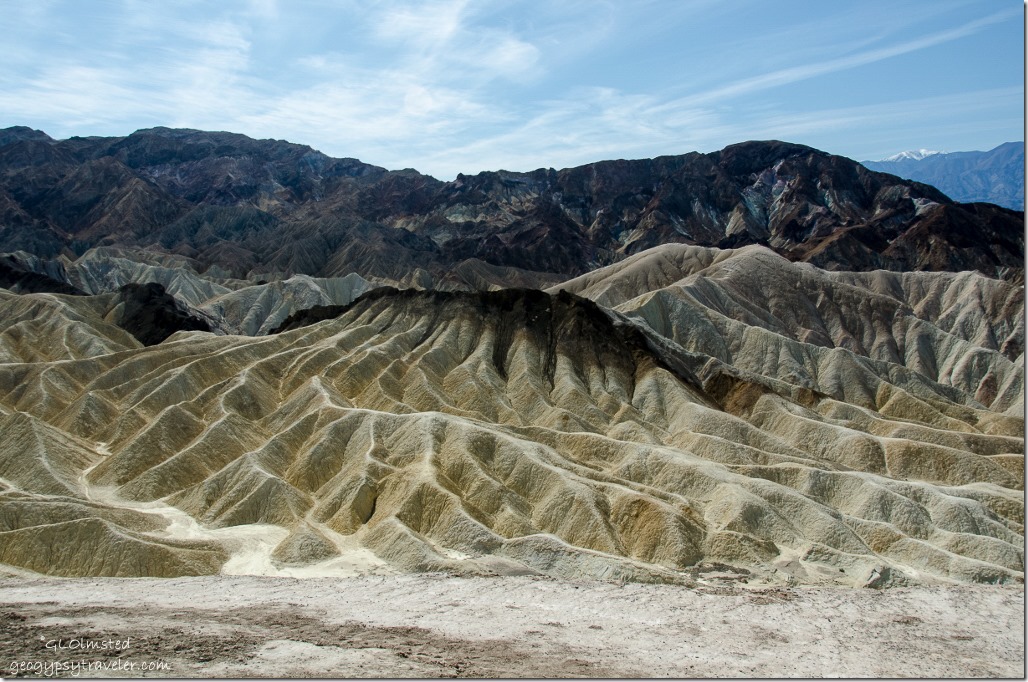 The dark-colored material capping the badland ridges is lava from eruptions that occurred 3-5mya. The layers are constantly being tilted by seismic activity and pressure, uplifted and eroded.
The dark-colored material capping the badland ridges is lava from eruptions that occurred 3-5mya. The layers are constantly being tilted by seismic activity and pressure, uplifted and eroded.
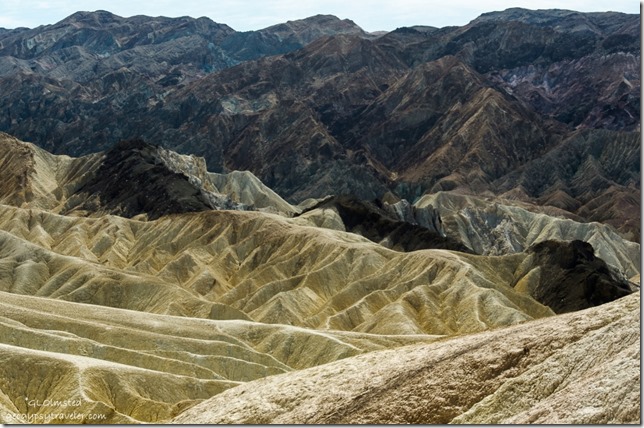 Imagine what it looks like here during a gully washer. The folds look like ripples of satin to me.
Imagine what it looks like here during a gully washer. The folds look like ripples of satin to me.
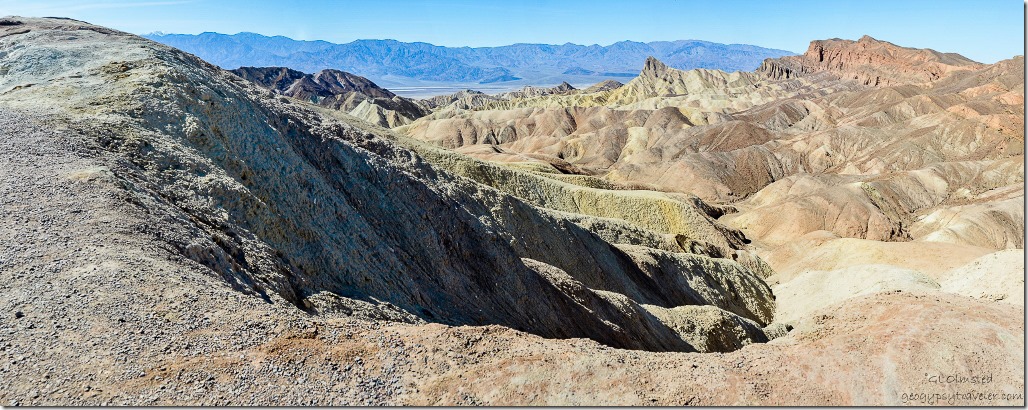 No surprise this location was used in movie making. One 1970 counterculture film named after the iconic overlook is not highly acclaimed yet the soundtrack features music by Pink Floyd, The Rolling Stones, Jerry Garcia and more so can’t be all bad.
No surprise this location was used in movie making. One 1970 counterculture film named after the iconic overlook is not highly acclaimed yet the soundtrack features music by Pink Floyd, The Rolling Stones, Jerry Garcia and more so can’t be all bad.
 The overlook was named after Christian Zabriskie, vice-president and general manager of the Pacific Coast Borax Company in the early 1900s. The company’s twenty-mule teams were used to transport borax from its mining operations in Death Valley until the 1920s when borax was in low demand. So the company looked for other uses for their land and opened Furnace Creek Inn in 1927. They then initiated for protection of Death Valley which became a National Monument in 1933 and a National Park in 1994.
The overlook was named after Christian Zabriskie, vice-president and general manager of the Pacific Coast Borax Company in the early 1900s. The company’s twenty-mule teams were used to transport borax from its mining operations in Death Valley until the 1920s when borax was in low demand. So the company looked for other uses for their land and opened Furnace Creek Inn in 1927. They then initiated for protection of Death Valley which became a National Monument in 1933 and a National Park in 1994.
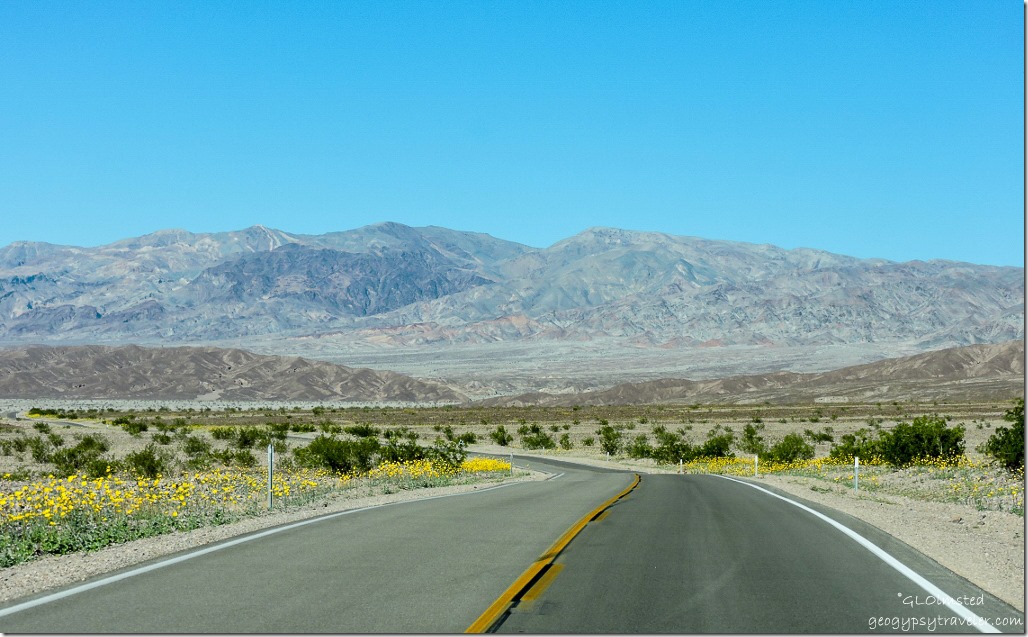 From Zabriskie Point we drove past Furnace Creek Inn then north through the flowers to hike in Titus Canyon Narrows.
From Zabriskie Point we drove past Furnace Creek Inn then north through the flowers to hike in Titus Canyon Narrows.

